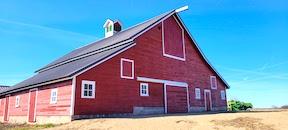
Sadly, thousands of unused barns have quickly deteriorated or been torn down in recent decades because dairying and livestock production have changed dramatically. A unique “thresher” barn near Janesville, Minn., has avoided that fate because Matt Crellin and his siblings Mark and Kathleen, great-grandchildren of Michael Keeley, who built the barn in 1886, have restored it. The Janesville, Minn., newspaper noted in a feature story that summer that “it’s one of the finest barns in the county.” Once again, it has that distinction.
“The barn and farmstead hold special memories for our family because our mother grew up there, and our family, along with two aunts, visited often,” Matt says. “Our grandmother and her four single sons lived there and ran the farm. They kept the barn in great shape, stabilizing it with a new foundation in the 1940s and a new cedar shingle roof in the 1970s.” The barn began deteriorating when two brothers passed away, and the other two brothers quit dairying. When their last uncle, Frank, passed in 2021, the Crellins decided to restore it.
“We wanted to keep the home place in the family and preserve our Irish ancestor’s agricultural heritage for our nephew and his wife, who plan to build a new house on the farm site,” Matt says.
The original 56-ft. by 56-ft. structure was unique to the area. It had a center bay with a wooden floor used for hand-threshing grain in the winter. Two bays on either side stored grain harvested in the summer, and two others were added for horses on one side and a few cows and pigs on the other. The structure was supported by 18 wooden posts placed on top of large boulders for footings. About 13,000 board feet of native lumber harvested in nearby woodlands and 19,000 board feet from the Winona Lumber Company were used to build it. The Winona lumber was delivered by rail, unloaded about 1/2 mile from the farm, and hauled there by horse and wagon.
With the advent of steam threshing in the early 1920s, Matthew Keeley, the Crellin’s grandfather, remodeled it in 1925 and converted it for dairying. He removed the wooden floor, strengthened the foundation, and added a hay loft and a milking parlor on the south side. An oak stave silo was built on the southwest corner and stood until a storm knocked it down in the 1980s. The Keeleys milked cows in the barn for more than 60 years.
To restore the barn, the Crellins contacted the Waseca County Historical Society, who put them in touch with barn restoration specialist Jay Schmidt. They contracted his company to do the work, which was completed in December 2023.
“The roof was in tough shape, the siding was faded, and the windows were sagging in their frames when the restoration started,” Matt says. “And even though Frank didn’t have any cattle in it for many years, the barn was nearly full of hay. One of the ‘saving graces’ for the restoration was that the original structure was straight and true.”
Over the next 2 years, Schmidt’s crew removed the hay, reinforced the frame, repaired the siding, installed a new steel roof, and replaced the windows. When they replaced the cupola, they found that the main ridge was still perfectly level. Two coats of barn red paint brought the structure back to “nearly new” condition. The barn is once again a bright red landmark for travelers on the busy nearby four-lane U.S. Highway 14, which cuts through the middle of the original farm.
Matt says, “It’s important that the barn be preserved so the next generation can continue our family legacy on the farm. Thousands of people can now see the barn daily while passing on the busy highway, knowing it’s a landmark that will be preserved for a long time.
Contact: FARM SHOW Followup, Matt Crellin (mjcrellin@gmail.com).
